CUMBRES & TOLTEC TRAIN (Day 2 - part 1)
Today was an early day. Fortunately the thoughts of a HUGE buffet breakfast made it easier to get out of bed! On the menu were bagels, biscuits, toast, donuts, cereal, yogurt, granola, apples, bananas, oranges, eggs, meat, gravy, harsh browns, juice, coffee, etc.... even non-dairy and gluten-free upon request.


Best of all, one could make one's own waffles!

Yum!
We then headed to Great Sand Dunes National Park and Preserve. We got there a bit too early though as the visitor center hadn't opened yet. We would have happily waited the 15 minutes had it not been for GIGANTIC swarms of incredibly aggressive mosquitos! We walked briefly to the back of the building to get some quick views, then raced back to the car. We spoke to another couple who were walking up. They had tried to go hiking but said they had to turn back... even while wearing repellant! Unfortunately the mere act of opening the car doors allowed the pesky creatures to flood in. It took quite a few minutes of being on the road before we were able to blow them all out.

This area became a National Monument in 1932 and then a National Park in 2004. The park covers 69 square miles (with 30 square miles of that being the tallest sand dunes in North America) and the preserve protects an additional 65 square miles (which includes six alpine peaks, ancient spruce and pine forests, grasslands and wetlands).
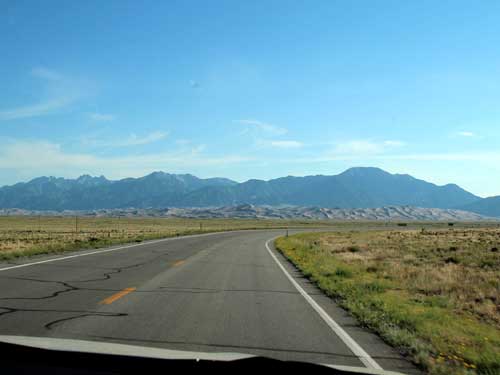
Approaching the dunes
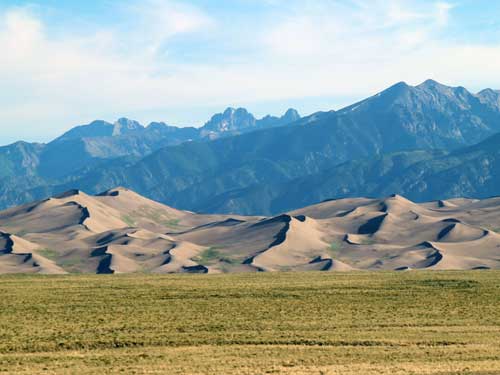

The visitor center

It is believed that the dunes started forming less than 440,000 years ago. Sand and soil deposits from the Rio Grande (as it flowed through the San Luis Valley) were picked up by westerly winds. When the wind hit the Sangre de Cristo Range, the sand was dropped. This process continued and the dunes grew. Streams from the mountains running along the edges of the dunes carried stray sand downstream. Winds pick it up and blew it back onto the top of the dunes once again.

Click for a larger view

Click for a larger view

Click for a larger view
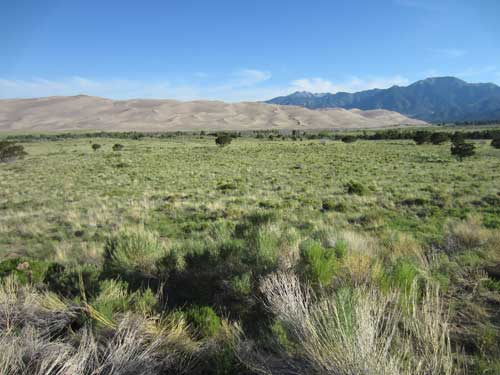

We arrived at the small town of Antonito (population less than 800 people).


What was surprising were the number of marijuana dispensaries for such a tiny place. Denver or Boulder, sure... but here? Apparently the town has switched from sheep herding to the more lucrative drug tourism, which has become rampant in the state ever since Colorado legalized marijuana for recreational purposes in 2012 (mind you, at this time it is still illegal according to the federal government).
When it was first legalized, it felt like there were very few rules. Dispensaries popped up everywhere, often several per block. Many people started converting that extra room (or two) in their house into a grow room. The smell was absolutely everywhere because people smoked it in public as freely as cigarettes. A mountain hike no longer provided just the smell of fresh air. While rules have tightened up (for example, dispensaries can no longer open up next to a school, and police do sometimes give fines for blatant offenses), it is still frequently abused as many of the rules are seldom adhered to.
So while it is legal, there are limitations:
- You must be 21 years old to purchase, possess or use retail marijuana.
- It is illegal to use marijuana in a public place (bars, parks, campsites, music venues, sidewalks) or on federal land (national parks).
- As with alcohol, it is illegal to be under the influence while driving. It's also illegal to have an open package in the car.
- It is illegal to transport it beyond Colorado's borders.
- You can only possess up to one ounce at a time and only purchase it from a licensed retailer.
- Coloradans can only grow up to 6 plants at a time.
- It is a felony to give it to a anyone under 21. In general, keep it away from children, just as with pharmaceuticals. Marijuana smoke (even secondhand smoke) also has many of the same cancer-causing chemicals as tobacco smoke.


We, however, weren't there for that but rather the historic Cumbres & Toltec Scenic Railroad. We picked up our tickets at the depot then had a bit of time to kill before boarding.
Antonito is home to Our Lady of Guadalupe Catholic Church, the oldest church in the Colorado, built in 1857. Since it was located only a mile or two away, we decided to pay it a visit. Unfortunately it was closed, even during posted open hours.
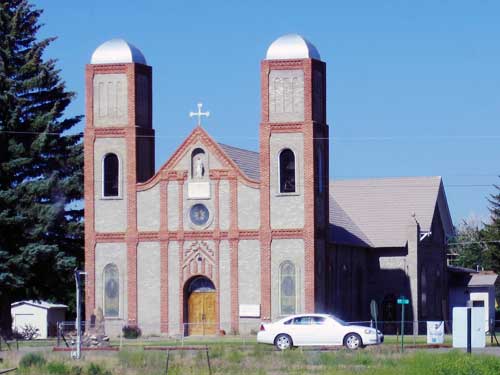

We returned to the depot and waited for the train to begin boarding.

Fire in the distance?? Nope... that's just our ride!
The Cumbres & Toltec Scenic Railroad is the longest, highest and most complete example of a late 1800's and early 1900's narrow gauge railroad in the country. Steam trains run the 64-mile stretch of track that stretches between Chama (New Mexico) and Antonito (Colorado), over the 10,015-foot Cumbres Pass and through the Toltec Gorge. In 1970, it (along with much of the equipment that operated on the line) was jointly purchased by Colorado and New Mexico from the Denver and Rio Grande Western Railway, saving it from the scrap yards. It became a National Historic Landmark in 2012 by the US National Park Service.

We were going to take the train from Antonito to Chama, then a bus back along Hwy 17.

The Colorado flag is depicted on the left, the New Mexico flag is on the right.
Animals created the first paths across Cumbres Pass, followed by Native Americans, then various trappers and traders, and finally miners and emigrants in 1876. The road was 'built' by the cattle, horses and wagons as they labored their way across it. In 1877, a official, crude road was started by a toll road company to the top of the pass, with a toll gate at Osier. While there is very little surviving written history of the toll road, it is assumed it had standard tolls of the time: 15 cents for a man on horseback and $1.75 for a 12-horse team and wagon; sheep cost half a cent and cattle were 2 1/2 cents. By 1923, after the building of State Highway 17, the old road fell into disuse.
Here is a description of a trip made by the Pargin family and the Quick brothers in early 1877 as they crossed the pass on their way from Missouri: There was practically no trail and in many places it required six horses to pull one wagon up the slope. As there were three wagons in the party, it frequently took three separate trips to get over the steep places. The descent of the range was more difficult than the ascent. The men often had to let the wagons down the side of the mountains by means of ropes.
The railroad line was constructed in 1880-1881 by the Denver and Rio Grande Railroad as part of their San Juan extension, which ran from Alamosa to Durango. It primarily supported mining operations in the San Juan mountains, mostly around Durango and Silverton. The section of the tract we'll be on today was constructed in 1880 in less than nine months.
By the 1950's, mining had dwindled and the line was basically abandoned by the late 1960's.
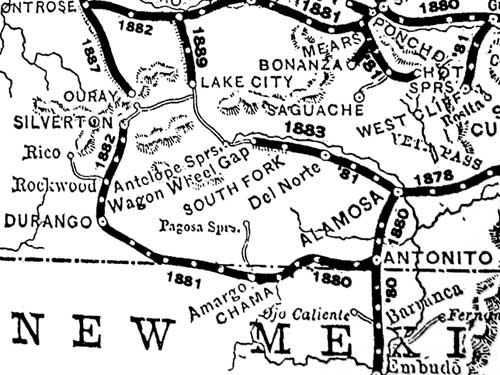
Railroad lines in Colorado in 1883 (Click for a view of the full map)

Click for a larger view
Unlike the standard gauge of the Pikes Peak cog railway that we were on yesterday, this track was only 3 feet wide. Narrow-gauge railways are cheaper to build (an advantage where there isn't a high volume to traffic to cover the cost) but also better in mountainous or difficult terrain (where there are sharper curves and more limited space).

An engine jumps the track in 1904

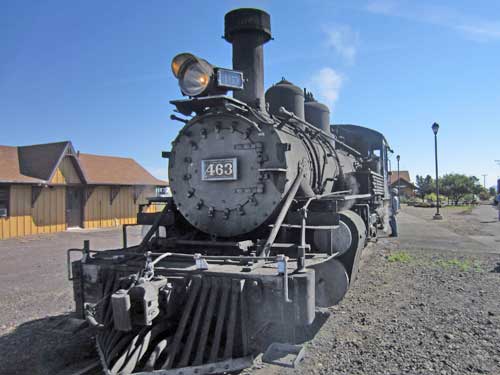
Engine number 463 was built in 1903. It can carry 4,100 gallons of water and 8.5 tons of coal. It is the oldest (and the smallest) engine in the fleet.


Blowin' off steam

Checking the gauges

Because Antonito could handle both standard and narrow gauge trains, it had both sets of tracks. It's easy to see the width difference here.
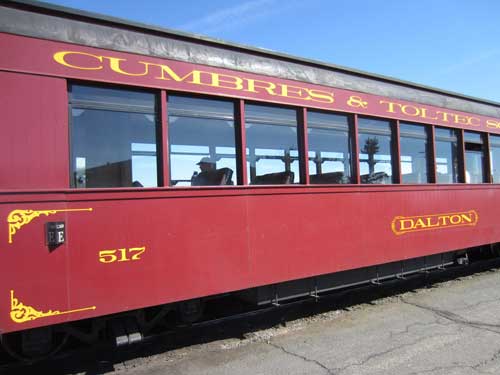
Our car

The viewing car, where we could go if wished once the train was in motion

The end of the train... but not the caboose!
The caboose used to be the last car in a train and provided a rolling office (and potentially living quarters for longer hauls) for the conductor and the brakemen. Early cabooses were nothing more than modified box cars or flat cars with small cabins on them. Even though this system was used for over 100 years, it had some big issues. For one, communication between the conductor (in the back) and the engineer (in the front) was sometimes a problem. Second, being in a caboose was like being at the end of a long whip, sometimes resulting in the both the crew and heavy equipment being snapped about.
With the advancement of technology, large train crews and eventually the caboose were no longer needed. Air brakes replaced dozens of brakemen; locomotives changed from steam to diesel; electronic communication bridged gaps; detectors were installed to signal and locate problems; cars were better designed to avoid problems with the loads; and cabooses became replaced by small little electronic devices called FRED (Flashing Rear End Device). By the 1980's, the caboose was obsolete.
For most of the 20th century, freight train crews consisted of a conductor, two brakemen, an engineer and a fireman (an apprentice engineer who stoked the fire and maintained steam pressure in the boiler). Today most of these trains only need a conductor and an engineer.
ENGINEER: The engineer doesn't just run the engine, he runs the entire train. He controls the speed, is responsible for momentum and the braking of all the cars, factors in grades and curves, listens to the yardmaster and dispatchers as not to have a collision with another train or end up on a damaged track, follows timetables and signals, watches the track for obstructions;, blows the whistle to signal others; and plans in advance for stops or sidings.
CONDUCTOR: The conductor is responsible for the safety of the crew, cargo and equipment. He takes care of the paperwork, observes safety procedures for dangerous or hazardous materials, makes sure every car is in good operating condition and that loads are secure, checks that the air brakes are connected and working, supervises all rules and speed restrictions, communicates with the engineer, ensures the train has enough fuel, and is usually the guy who takes your tickets.
BRAKEMAN: The brakeman seems to get most of the grunt work: throwing the track switches. coupling and uncoupling cars, setting and releasing hand brakes, shifting loads, hauling equipment, and keeping a lookout for potential hazards on the train itself.


Wow! Gorgeous! Unfortunately this was not our car...

... this was.

Joanne examines our route.

Our route. Note the train crosses the border 11 times. (Click for a larger view)
return • continue

